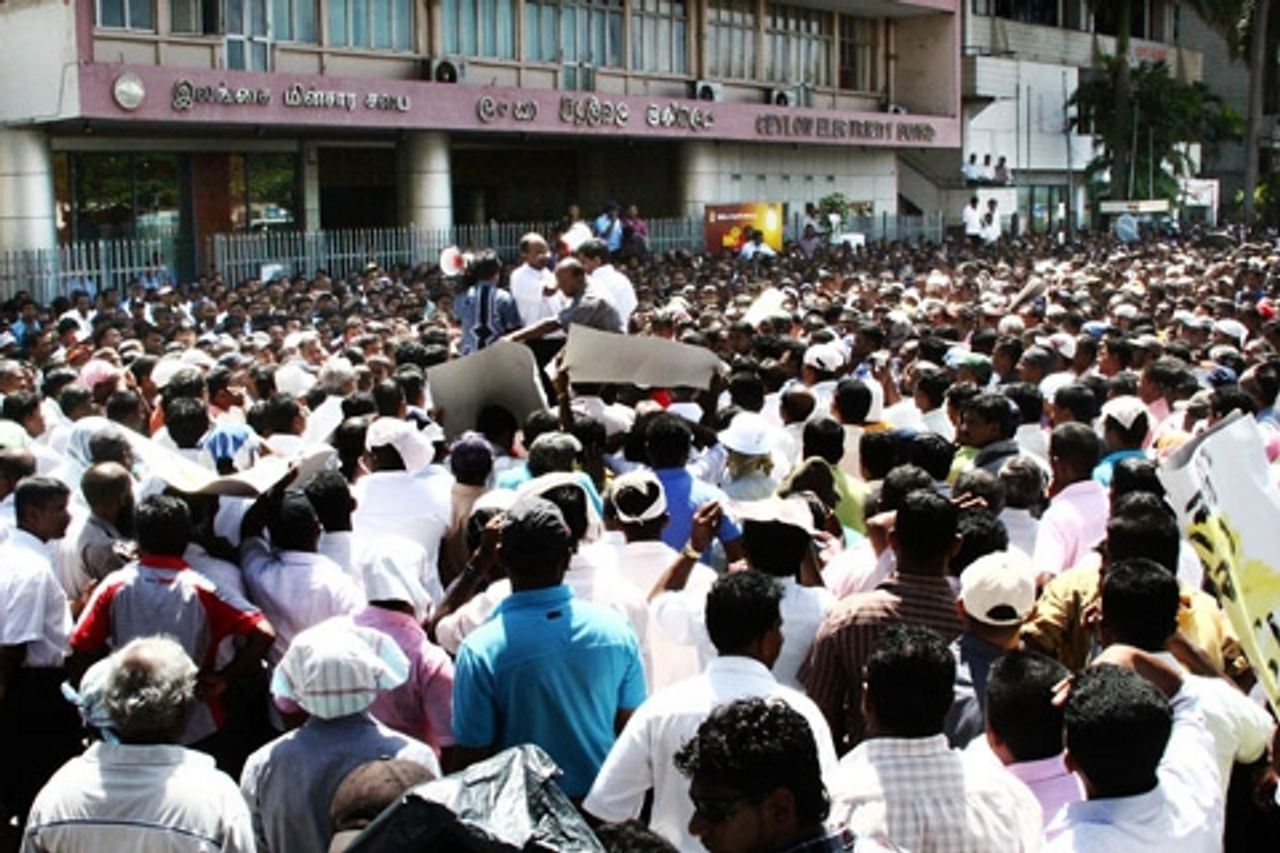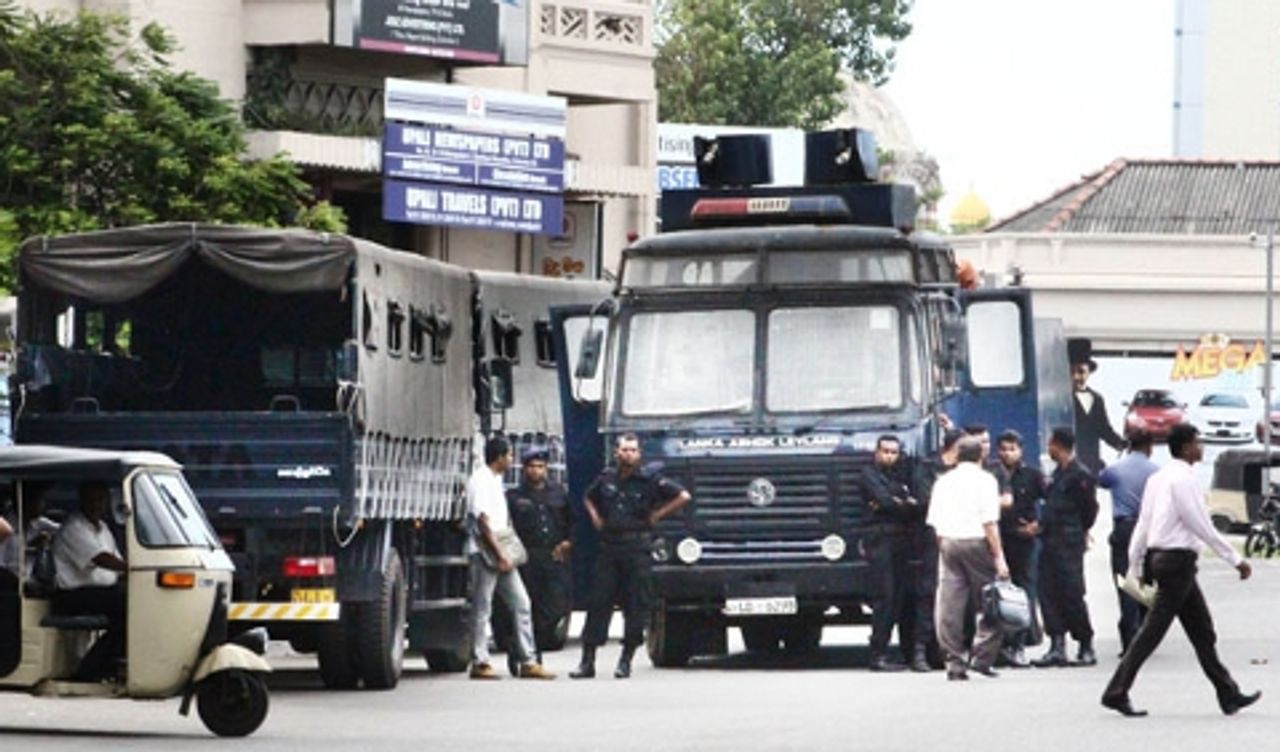The Ceylon Electricity Board (CEB) trade unions last Friday bowed to threats issued by the Sri Lankan government and sold out a week-long strike by 15,000 power workers.
The strike over wages and conditions was called by the CEB United Trade Union Front (UTUF), which is led by the Ceylon Electricity Workers Union affiliated to the opposition Janatha Vimukthi Peramuna (JVP), and the Technical Services Trade Union Front (TSTUF). The CEB engineers’ union opposed the industrial action.
In calling off the strike, the unions accepted the government’s main demands, including a pledge to take no further industrial action until a committee appointed by the Labour Commissioner has brought down its recommendations.
 Power workers protesting outside CEB headquarters
Power workers protesting outside CEB headquartersThe unions also withdrew key demands, related to the workers’ opposition to the privatisation of consumer service centres and to the exploitation of contract and temporary workers. The call for 5,000 contract workers to be made permanent has been dropped. The Labour Commissioner’s committee will deal with the remaining demands for a 20 percent pay increase as well as the withdrawal of disciplinary threats.
The committee’s deliberations could be drawn out for months, with the recommendations to be presented by November 20. If no agreement is reached, the Labour Minister will appoint an arbitrator to consider the demands, which could drag on even longer. Sri Lankan industrial laws prohibit strike action during arbitration. In effect, the unions have ended the strike with nothing but vague promises and, in doing so, have opened the door for a further assault on jobs, wages and conditions.
In line with the demands of the International Monetary Fund (IMF), President Mahinda Rajapakse has slashed price subsidies, sharply raising the cost of fuel, transport and basic food items.
The CEB unions called the strike on August 10 in an attempt to defuse mounting anger among workers over deteriorating pay and conditions and the threat of privatisation. The action was merely intended to let off some steam. From the outset it was clear that struggle for the workers’ demands could not be advanced without a political fight against the President Mahinda Rajapakse government. Opposing such a political fight, the unions betrayed the workers.
 Police commandos near demonstrating power workers
Police commandos near demonstrating power workersRajapakse had threatened “tough action” against the strikers during a meeting with media editors last Monday. The CEB management contacted retired workers and announced that it was in the process of recruiting new hands. The Board then issued an ultimatum to employees to report for work by Friday or lose their jobs. In addition, government deployed the army to CEB workplaces to protect strike breakers.
The strikers were clearly in a defiant mood. Last Monday, more than 2,000 power workers from across the country demonstrated outside the CEB head office in Colombo. UTUF convenor and JVP union leader Ranjan Jayalal demagogically challenged the CEB management to try to run operations with hired hands. The UTUF, he said, would mobilise “political parties, other trade unions and civil organisations” to defend the CEB strikers.
As late as Thursday morning, Jayalal told a press conference: “We will not be reporting to work until our demands are met.” The union officials boasted that the CEB unions were setting an example for other unions to ignore government threats. By that evening, however, Jayalal and the other CEB leaders completely capitulated and came to talks with the Labour Commissioner to end the strike.
The government was clearly concerned that the strike would encourage other workers to fight for their rights. In particular, the opposition of strikers to privatisation threatened to cut across Rajapakse’s efforts to secure a new $US500 million loan from the IMF. The restructuring and sell-off of the CEB and the Ceylon Petroleum Corporation were among the “reform” measures demanded by the IMF for its previous $2.6 billion loan, granted in 2009.
The privatisation of the CEB began in 1990s. In 2009, the Rajapakse government passed legislation to outsource power generation and distribution. The private sector currently controls 43 percent of Sri Lanka’s power supply.
From the outset of the strike, the unions did everything possible to avoid a political confrontation with the government. They continued to promote the dangerous illusion that Rajapakse could be pressured to make concessions. Neither the JVP, the right-wing opposition United National Party, nor their affiliated unions has any fundamental differences with the IMF austerity agenda that the government is implementing.
The JVP joined a coalition government with Rajapakse’s Sri Lanka Freedom Party in 2004, backed Rajapakse during the 2005 presidential election, and supported his renewed war against the separatist Liberation Tigers of Tamil Eelam in 2006. During the war, the unions helped to suppress workers’ struggles by demanding that the working class sacrifice to “defend the motherland.” Since the end of the war in 2009, the JVP and its unions have played the main role in stifling struggles for wage increases.
In the current dispute, the union promoted the fraud that the government would not try to suppress the strike because Sri Lanka was under scrutiny over its human rights record during the war. The US and its European allies have raised the issue, not because of any concern over the democratic rights of Tamils, or workers, but to pressure the Sri Lankan government to align more closely with the West. Predictably, there have been no protests by the US over the use of the army against striking workers.
The betrayal of the CEB strike underscores the necessity of power workers taking matters into their own hands. CEB employees should reject the decision to enter the Labour Commissioner’s committee, break from the unions and form their own rank-and-file committees to fight for decent wages and conditions and to oppose privatisation.
Such a campaign necessarily involves a political struggle against the Rajapakse government. Power workers must turn out to other sections of the working class in Sri Lanka and internationally confronting similar attacks, on the basis of the fight for a workers’ and peasants’ government and socialist policies. That is the perspective fought for by the Socialist Equality Party.
Subscribe to the IWA-RFC Newsletter
Get email updates on workers’ struggles and a global perspective from the International Workers Alliance of Rank-and-File Committees.
